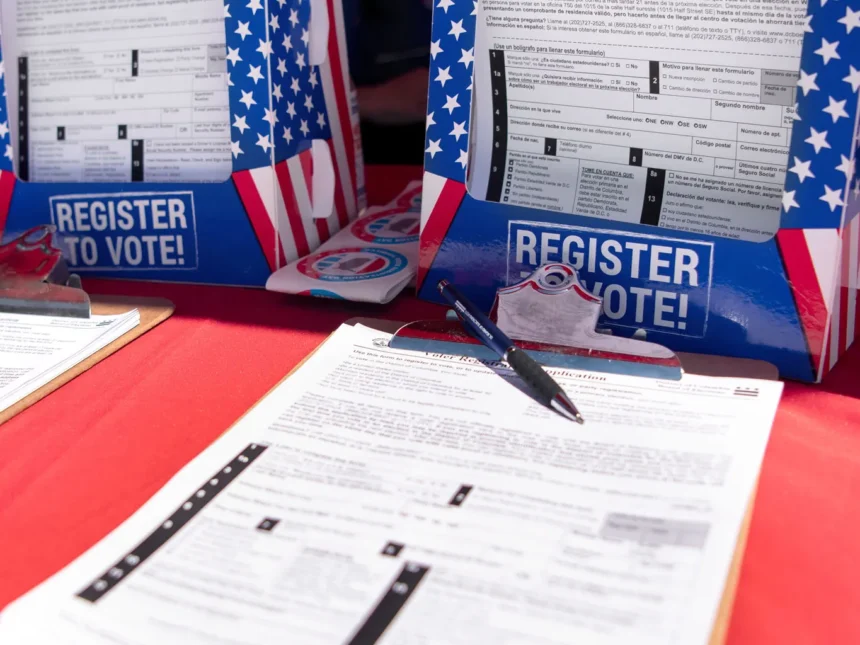NEW YORK – The Democratic Party is facing a tough moment, with party registration numbers falling in every state that reports political affiliation. Across the United States, Democrats are losing registered voters at an accelerating pace, with many switching to the Republican Party or becoming independents.
The decline is especially steep among single men (including Black and Hispanic men), voters under age 35, and working-class men, all groups that once made up the core of the Democratic coalition. Major donors are also starting to step back, frustrated by the party’s focus on policies that appeal to only a small fraction of voters. If the Democrats don’t change course, they risk slipping into long-term irrelevance.
Shrinking Democratic Voter Base from Coast to Coast
Recent numbers show just how serious the situation is. A New York Times analysis found that in all 30 party-registration states (and Washington, D.C.), the share of registered Democrats dropped from 2020 to 2024. In those states, Republicans either pulled further ahead or closed gaps with the Democrats. Between 2020 and 2024, Democrats lost 2.1 million registered voters, while Republicans gained 2.4 million. That’s a shift of 4.5 million voters in the GOP’s favour.
Battleground states are seeing the sharpest drops. In North Carolina, Republicans erased almost all of the Democrats’ 2020 registration advantage. In Nevada, Democrats experienced the largest percentage decline outside of West Virginia, with Republicans even overtaking them for a period in 2024.
Florida and New Hampshire now have more registered Republicans than Democrats. Even in traditional Democratic strongholds like Pennsylvania and Nevada, the gap is closing, with Nevada showing just under 4,000 more Democrats than Republicans by August 2025.
This problem is widespread, not just regional. Back in 2018, Democrats made up about 34% of new voter registrations versus 20% for Republicans. Fast forward to 2024,
Republicans have not only closed the gap, but now claim a larger share of new registrants. The GOP’s share jumped by 9 percentage points, while the Democratic share fell by nearly 8. For new party registrants, Democrats’ portion dropped from almost two-thirds to under half. This is especially noticeable since most new voters are young and nonwhite—groups once solidly in the Democratic camp—that now are picking the GOP or declining any affiliation.
There’s another trend adding to the party’s trouble: more people are registering as unaffiliated or independent than ever before. Since 2000, the share of unaffiliated American voters has grown by nearly 9 percentage points, mostly at the expense of Democrats. In 2023, a record 43% of adults described themselves as independents, while only 27% identified as Democrats. This shows growing dissatisfaction with the party and a move away from traditional labels.
Key Demographics Walk Away from the Party
This isn’t just about numbers. The core groups that used to keep the Democratic Party strong are now leaving. Economic worries, cultural issues, and a disconnect with the party’s current focus are pushing these voters to reconsider their loyalty.
Single Men, Including Black and Hispanic Men
Few trends stand out more than the shift among single men, especially in Black and Hispanic communities. In 2020, nearly half of newly registered men who picked a major party chose the Democrats. By 2024, it was only 39%. More than 60% chose the Republicans in 2024, flipping a gender gap that once favoured Democrats.
This change is especially clear among Black men. Gallup reports that the Democrats’ advantage among Black adults hit a record low of 47 points in 2023, down from 66 points only three years earlier. In 2014, almost 8 in 10 Black men identified as Democrats or leaned left.
By 2023, that had dropped to just under 6 in 10. Black voters still largely support Democrats in presidential races, but the party is seeing more and more Black men step away. Younger Black men seem especially skeptical, with a little over half rating President Joe Biden positively.
Hispanic men are moving as well. Florida saw the Democratic share of new Latino party registrants fall from 52% in 2020 to 33% in 2024. In North Carolina, the drop was from 72% to 58%.
Many Hispanic voters, especially in places like Starr County, Texas (the nation’s most Latino county), named everyday economic struggles like gas and rent prices as their main reasons for supporting Donald Trump. The Democrats’ focus on progressive social issues over immediate pocketbook concerns hasn’t brought these voters back.
Voters Under 35
Young voters, once a solid base for the party, are shifting away as well. In 2018, about two-thirds of new voters under 45 choosing a party went with the Democrats. By 2024, Republicans will lead within this age group.
In Nevada alone, Republicans registered nearly twice as many voters under 35 as Democrats did last year. The Democrats’ share among new voters under 45 dropped much faster than it did for older age groups.
Young voters are also less likely to identify with any political party. Only about half of voters under 25 consider themselves allied with a party, compared to over three-quarters of those aged 80 and up.
If the Democratic Party can’t make stronger connections, it risks raising a generation of voters who don’t feel drawn to any party or who lean right. Experts warn that this could weaken the party’s ability to recruit strong candidates and keep its organization active in future elections.
Working-Class Men: The Lost Foundation of the Democratic Party
For decades, working-class men—often white voters without a college degree—were a big part of the Democratic base. These men have steadily shifted to the GOP, and the pace has only quickened recently. In 2024, almost two-thirds of white men without a college degree were with the Republicans. Just a third aligned with the Democrats.
This trend now includes blue-collar Hispanic and Black men. Exit polls from 2024 show non-college-educated and lower-income voters, including many Latinos, breaking heavily for Trump, pushed by worries over the cost of living and job security.
Democratic leadership, like Chris Deluzio in Pennsylvania, have admitted that the party’s focus didn’t connect with working-class voters on bread-and-butter issues. Many see the party’s messaging as distant or focused on priorities that do not relate to everyday struggles.
Trouble with Messaging and Ideology
Much of the current trouble can be traced back to choices about which policies and messages the party prioritizes. Moderate Democrats believe the party has gone too far left, focusing on issues that resonate mostly with activists, not everyday voters. These include things like expanded immigration policies, climate agendas, and certain social topics.
Figures like Representative Henry Cuellar say the party’s approach to issues like border security has backfired, especially with Latino voters concerned about migration. Progressive leaders, such as Alexandria Ocasio-Cortez, excite a small slice of the base, but their brand of politics has turned off many traditional voters.
In 2020, Republicans made “socialism” a dirty word in places like South Florida, helping them flip seats and narrow Democratic margins among Hispanic voters.
The party’s focus on issues like transgender rights and abortion is important to some, but it hasn’t reached working-class and minority voters who are focused on paying bills and keeping stable jobs.
One Democratic strategist summed up the problem: when the party addresses people in ways that feel out of touch with everyday experiences, even great ideas get ignored. In the current party base, only about 8% consider themselves “very liberal,” but party strategy seems to focus on this small group instead of trying to appeal more widely.
Money Problems and Donor Fatigue
The struggle doesn’t stop with voters. Democrats are having a harder time raising money. Reports suggest the party is “broke” compared to the Republicans, who are benefitting from a big rush of grassroots donations. Some of the party’s biggest donors have pulled back, blaming this on the party’s leftward move and the loss of connection with mainstream voters.
Registering new voters is costly, with each sign-up costing somewhere between $30 and $80. In 2020, recruiting a new Black voter for the Democrats cost an estimated $575 per vote.
Now, with donor support drying up, large-scale registration drives have slowed dramatically. Advocacy leaders like Héctor Sánchez Barba warn that cutting funds for Latino voter outreach is a mistake, but it has been hard to bring donors back on board.
A rising number of funds now flow through outside groups and super PACs, which act independently and have little coordination with the national party. This takes resources away from official Democratic efforts and weakens the party’s role in organizing, raising questions about leadership and strategy.
A Party Forced to Reconsider Its Future
The registration crisis is a warning sign of bigger problems that go beyond numbers or fundraising. Democrats need to reconnect with working-class communities and men by focusing on real economic priorities, not only progressive social policies.
The party also has to address the concerns of Black and Hispanic voters, many of whom have lost faith that it can deliver results. It will need a way to show donors that there’s a concrete path forward without leaving regular voters behind.
Some party leaders believe a backlash against Republican policies, especially with Trump back in the picture, could bring voters back, but there’s no sign of this happening yet. As of August 2025, Democrats continue to fall behind. Across the 30 states with party registration, Democrats counted 160,000 fewer voters than on Election Day 2024, while Republicans grew by another 200,000.
Disagreement over the way forward is growing. Moderates like Representative Cuellar push for a centre-left approach that appeals to everyday people, while progressives like Representative Pramila Jayapal call for big changes, acknowledging the party has become too focused on well-educated elites. Veteran strategist Maria Cardona says it’s simple: “We fell asleep at the switch.”
The Democratic Party stands at a key turning point. The drop in registered voters—driven by the loss of single men, youth, and working-class men—shows the party’s message no longer lands with its base.
Focusing tightly on far-left policies draws activists, but drives away swing voters needed for future wins. Add the party’s money problems and shrinking donor trust, and the challenge grows. If these trends keep going, the Democrats will lose even more ground to Republicans and independents, putting their chances for 2028 and later races at risk. The party has a choice: change strategy or face even more losses in the years ahead.











